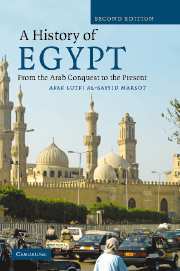Book contents
- Frontmatter
- Contents
- List of maps
- Preface
- Map 1 Egypt and its neighbours
- Map 2 Medieval Cairo
- 1 The Arab conquest of Egypt to the end of the Ayyubi dynasty, 639–1250
- 2 The age of the mamluks, 1250–1516
- 3 The Ottoman age, 1516–1805
- 4 The beginning of the state system, 1805–1922
- 5 The liberal experiment, 1922–52
- 6 The Nasser years, 1952–70
- 7 From Sadat to Mubarak, 1970 to the present day
- Select bibliography
- Index
6 - The Nasser years, 1952–70
Published online by Cambridge University Press: 05 June 2012
- Frontmatter
- Contents
- List of maps
- Preface
- Map 1 Egypt and its neighbours
- Map 2 Medieval Cairo
- 1 The Arab conquest of Egypt to the end of the Ayyubi dynasty, 639–1250
- 2 The age of the mamluks, 1250–1516
- 3 The Ottoman age, 1516–1805
- 4 The beginning of the state system, 1805–1922
- 5 The liberal experiment, 1922–52
- 6 The Nasser years, 1952–70
- 7 From Sadat to Mubarak, 1970 to the present day
- Select bibliography
- Index
Summary
For the first time in over two thousand years, since the days of the Pharaohs, Egypt was ruled by Egyptians. The Turco-Circassian monarchy sustained and bolstered by British guns was gone. At last it seemed the alienation of the ruled from their rulers was to come to an end. The new regime was one with which the majority of native Egyptians could identify in terms of religion, language and ethnicity, the Coptic minority being an exception as far as religion was concerned. Like his grandfather, the monarch was deposed without a voice being raised in his favour.
The loss of the monarchy led many to believe that it also meant the end of British meddling in Egyptian internal politics, for British influence within Egypt was associated with the presence of a king who could dismiss governments when ordered to do so. The advent of nationalists to power, in somewhat the same fashion as the advent of the first government under the Wafd, seemed to inspire a belief that a purely Egyptian government operating for the well-being of Egyptians had been established. Everyone believed the officers were nationalists who wanted to reform the country.
Most of the Free Officers had entered the military academy after the treaty of 1936 had made this possible. Most were members of the same graduating class, had served together in military posts and were friends as well as companions in arms.
- Type
- Chapter
- Information
- A History of EgyptFrom the Arab Conquest to the Present, pp. 127 - 155Publisher: Cambridge University PressPrint publication year: 2007



